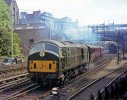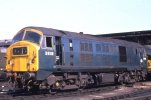This thread inspired me to do a bit more background research for interest, and from pictures I too was surprised to find that the Class 21/29 and 22 had spoked wheels, rather than discs, as I can now see others have noticed! The contemporary Class 41 (another NBL product) also had spoked wheels, at least at first.
The Class 25s and Class 24s (BR designed and built) had disc wheels but far more perforated discs which look at first sight like spokes but aren't. By the Class 26, BR were fitting what we would recognise today as a disc locomotive wheel. Presumably BR were using steel or wrought iron and NBL were still using cast iron? Swindon produced their distinctive profile of discs for the Westerns and Warships at around the same time.
I struggled to find many clear images and don't want to clutter the thread with hotlinks anyway, but this incredible resource confirms and there are a few images online that are at the right angle and with enough contrast and backlight to be able to see the spokes.
http://www.clag.org.uk/wheelbase.html
This also states the Class 41 wheels were later replaced with discs. I think there is an error here that the 83s were stated to have spoked wheels, but I think this should be Class 84.
Was there a specific reason to produce spoked wheels or it just a traditional loco builder sticking to established techniques?
Were the wheels prone to fractures and failures?
You've answered one of my questions already here

I referred to Swindon above, and of course that worksho
This thread inspired me to do a bit more background research for interest, and from pictures I too was surprised to find that the Class 21/29 and 22 had spoked wheels, rather than discs, as I can now see others have noticed! The contemporary Class 41 (another NBL product) also had spoked wheels, at least at first.
The Class 25s and Class 24s (BR designed and built) had disc wheels but far more perforated discs which look at first sight like spokes but aren't. By the Class 26, BR were fitting what we would recognise today as a disc locomotive wheel. Presumably BR were using steel or wrought iron and NBL were still using cast iron? Swindon produced their distinctive profile of discs for the Westerns and Warships at around the same time.
I struggled to find many clear images and don't want to clutter the thread with hotlinks anyway, but this incredible resource confirms and there are a few images online that are at the right angle and with enough contrast and backlight to be able to see the spokes.
http://www.clag.org.uk/wheelbase.html
This also states the Class 41 wheels were later replaced with discs. I think there is an error here that the 83s were stated to have spoked wheels, but I think this should be Class 84.
Was there a specific reason to produce spoked wheels or it just a traditional loco builder sticking to established techniques?
Were the wheels prone to fractures and failures?
You've answered one of my questions already here

I referred to Swindon above, and of course that workshop was one of the greatest and most advanced/skilled railways works in the world at that time.
p was one of the greatest and most advanced/skilled railways works in the world.














